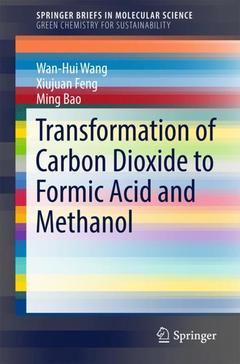Description
Transformation of Carbon Dioxide to Formic Acid and Methanol, 1st ed. 2018
SpringerBriefs in Green Chemistry for Sustainability Series
Authors: Wang Wan-Hui, Feng Xiujuan, Bao Ming
Language: English
Subjects for Transformation of Carbon Dioxide to Formic Acid and Methanol:
52.74 €
In Print (Delivery period: 15 days).
Add to cartSupport: Print on demand
Description
/li>Contents
/li>Biography
/li>Comment
/li>
This brief explains the principles and fundamentals of carbon dioxide utilization and highlights the transformation to fuels and value-added chemicals such as formic acid and methanol. It is divided into six chapters, including an introduction to the basics of CO2 utilization and transformation of CO2 to formic acid and methanol with homogeneous and heterogeneous catalysts, respectively. The brief will appeal to a wide readership of academic and industrial researchers focusing on homogeneous and heterogeneous catalysis, organometallic chemistry, green chemistry, energy conversion and storage.
Introduction: basics of CO2 utilization.- Transformation of CO2 to formic acid with homogeneous catalysts.- Transformation of CO2 to formic acid with heterogeneous catalysts.- Transformation of CO2 to methanol with homogeneous catalysts.- Transformation of CO2 to methanol with heterogeneous catalysts.- Perspectives.
Wan-Hui Wang received his Ph.D. from Saitama University, Japan in 2011. Thereafter he carried out his postdoctoral research with Dr. Y. Himeda at the National Institute of Advanced Industrial Science and Technology (AIST). In 2014, he joined the School of Petroleum and Chemical Engineering at Dalian University of Technology as an associate professor. His research interests lie in chemical energy storage and utilization of carbon dioxide.
Xiujuan Feng received her Ph.D. from Dalian University of Technology in 2004. She then joined the same university as a lecture and was prompted to associate professor in 2010. She was a visiting scholar at University of Minnesota from 2014 to 2015. Her research interests include transformation and activation of CO2, especially the reaction between epoxides, dienes and CO2.
Ming Bao received his M.S. from Northeast Normal University, China in 1989. After worked at the same university for eight years,
he transferred to the group of Prof. Yoshinori Yamamoto at Tohoku University, Japan, where he received his Ph.D. in 2001. From 2001 to 2004, he conducted postdoctoral research at the National Institute of Advanced Industrial Science and Technology (AIST), Japan, with Dr. Shigeru Shimada and Dr. Masao Shimizu. In 2005, he joined Dalian University of Technology as a professor. His current research interests focus on the development of novel synthetic methodologies using transition-metal catalysts.



